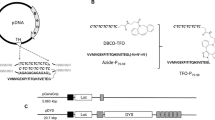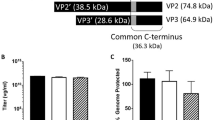Abstract
The development of effective receptor-targeted nonviral vectors for use in vivo is complicated by a number of technical problems. One of these is the low efficiency of the conjugation procedures used to couple protein ligands to the DNA condensing carrier molecules. We have made and characterized a multi-domain protein (SPKR)4inv, that is designed to target plasmid DNA to β1 integrins in remodeling tissue. It contains a nonspecific DNA-binding domain (SPKR)4, a rigid α-helical linker, and the C-terminal β1 integrin binding domain (aa 793–987) of the Yersinia pseudotuberculosis invasin protein. (SPKR)4inv could be purified at high yields using a bacterial expression system. We show that (SPKR)4inv binds with high affinity to both plasmid DNA and β1 integrins. In a cell attachment assay, the apparent affinity of (SPKR)4inv for β1 integrins is three orders of magnitude higher than that of the synthetic peptide integrin ligand RGDS. (SPKR)4inv–plasmid complexes are not active in an in vitro transfection assay. However, transfection efficiencies of plasmid complexes with a cationic lipid micelle (DOTAP/Tween-20) or a cationic polymer (polyethyl- enimine), are significantly increased in combination with (SPKR)4inv. (SPKR)4inv-mediated transfection can be inhibited by a soluble form of β1 integrin, which is evidence for its receptor specificity. In conclusion, (SPKR)4inv allows β1 integrin-specific targeting of plasmid–carrier complexes, while avoiding inefficient and cumbersome coupling chemistry. The modular design of the expression vector allows production of similar multi-domain proteins with a different affinity. The further development of such complexes for use in vivo is discussed.
This is a preview of subscription content, access via your institution
Access options
Subscribe to this journal
Receive 6 print issues and online access
$259.00 per year
only $43.17 per issue
Buy this article
- Purchase on SpringerLink
- Instant access to full article PDF
Prices may be subject to local taxes which are calculated during checkout










Similar content being viewed by others
References
Batra RK et al. Receptor-mediated gene delivery employing lectin-binding specificity Gene Therapy 1994 1: 255–260
Ziady AG et al. Ligand substitution of receptor targeted DNA complexes affects gene transfer into hepatoma cells Gene Therapy 1998 5: 1685–1697
Hoganson DK et al. Targeted delivery of DNA encoding cytotoxic proteins through high-affinity fibroblast growth factor receptors Hum Gene Ther 1998 9: 2565–2575
Perales JC et al. Gene transfer in vivo: sustained expression and regulation of genes introduced into the liver by receptor-targeted uptake Proc Natl Acad Sci USA 1994 91: 4086–4090
Boussif O et al. A versatile vector for gene and oligonucleotide transfer into cells in culture and in vivo: polyethylenimine Proc Natl Acad Sci USA 1995 92: 7297–7301
Baker A et al. Polyethylenimine (PEI) is a simple, inexpensive and effective reagent for condensing and linking plasmid DNA to adenovirus for gene delivery Gene Therapy 1997 4: 773–782
Plank C et al. Activation of the complement system by synthetic DNA complexes: a potential barrier for intravenous gene delivery Hum Gene Ther 1996 7: 1437–1446
Wagner E et al. Transferrin–polycation conjugates as carriers for DNA uptake into cells Proc Natl Acad Sci USA 1990 87: 3410–3414
Ogris M et al. PEGylated DNA/transferrin–PEI complexes: reduced interaction with blood components, extended circulation in blood and potential for systemic gene delivery Gene Therapy 1999 6: 595–605
Smith RM, Wu GY . Hepatocyte-directed gene delivery by receptor-mediated endocytosis Semin Liver Dis 1999 19: 83–92
Ferkol T, Kaetzel CS Davis PB . Gene transfer into respiratory epithelial cells by targeting the polymeric immunoglobulin receptor J Clin Invest 1993 92: 2394–2400
Hart S . Use of adhesion molecule for gene delivery Exp Nephrol 1999 7: 193–199
Shewring L et al. A nonviral vector system for efficient gene transfer to corneal endothelial cells via membrane integrins Transplantation 1997 64: 763–769
Sivolapenko GB et al. Imaging of metastatic melanoma utilising a technetium-99m labelled RGD-containing synthetic peptide Eur J Nucl Med 1998 25: 1383–1389
Herard AL et al. Fibronectin and its alpha 5 beta 1-integrin receptor are involved in the wound-repair process of airway epithelium Am J Physiol 1996 271: L726–L733
Pilewski JM et al. Expression of integrin cell adhesion receptors during human airway epithelial repair in vivo Am J Physiol 1997 273: L256–L263
Romanov V et al. Two novel probes reveal tubular and vascular Arg-Gly-Asp (RGD) binding sites in the ischemic rat kidney Kidney Int 1997 52: 93–102
Shih PT et al. Minimally modified low-density lipoprotein induces monocyte adhesion to endothelial connecting segment-1 by activating beta1 integrin J Clin Invest 1999 103: 613–625
Leong JM, Morrissey PE, Isberg RR . A 76-amino acid disulfide loop in the Yersinia pseudotuberculosis invasin protein is required for integrin receptor recognition J Biol Chem 1993 268: 20524–20532
Dersch P, Isberg RR . A region of the Yersinia pseudotuberculosis invasin protein enhances integrin-mediated uptake into mammalian cells and promotes self-association EMBO J 1999 18: 1199–1213
Hart S et al. Lipid-mediated enhancement of transfection by a nonviral integrin-targeting vector Hum Gen Ther 1998 9: 575–585
Erbacher P, Remy JS, Behr JP . Gene transfer with synthetic virus-like particles via the integrin-mediated endocytosis pathway Gene Therapy 1999 6: 138–145
Uherek C, Fominaya J, Wels W . A modular DNA carrier protein based on the structure of diphtheria toxin mediates target cell-specific gene delivery J Biol Chem 1998 273: 8835–8841
Paul RW et al. Gene transfer using a novel fusion protein, GAL4/invasin Hum Gene Ther 1997 8: 1253–1262
Khadake JR, Manchanahalli R, Satyanaranaya R . Condensation of DNA and chromatin by an SPKK-containing octapeptide repeat motif present in the C-terminus of histone H1 Biochemistry 1997 36: 1041–1051
Wilke M et al. Efficacy of a peptide-based gene delivery system depends on mitotic activity Gene Therapy 1996 3: 1133–1142
Gong Y et al. Structural analysis of the N- and C-termini in a peptide with consensus sequence Protein Sci 1995 4: 1446–1456
Leong JM, Fournier RS, Isberg RR . Identification of the integrin binding domain of the Yersinia pseudotuberculosis invasin protein EMBO J 1990 9: 1979–1989
Van Nhieu GT, Isberg RR . The yersinia pseudotubercolosis invasin protein and human fibronectin bind to mutually exclusive sites on the a5b1 integrin receptor J Biol Chem 1991 266: 24367–24375
Garcia AJ, Takagi J, Boettiger D . Two-stage activation for alpha5beta1 integrin binding to surface-adsorbed fibronectin J Biol Chem 1998 273: 34710–34715
Hajjar RJ et al. Modulation of ventricular function through gene transfer in vivo Proc Natl Acad Sci USA 1998 95: 5251–5256
D'Souza ST, Ginsberg MH Plow EF . Arginyl-glycyl-aspartic acid (RGD): a cell adhesion motif Trends Biol Sci 1991 16: 246–250
Harbottle R et al. An RGD-olygolysine peptide: a prototype construct for integrin-mediated gene delivery Hum Gene Ther 1998 9: 1037–1047
Eble J et al. Recombinant soluble a3b1 integrin: purification, processing, regulation, and specific binding to laminin-5cand invasin in a mutually exclusive manner Biochemistry 1998 37: 10945–10955
Isberg RR, Leong JM . Multiple beta 1 chain integrins are receptors for invasin, a protein that promotes bacterial penetration into mammalian cells Cell 1990 60: 861–871
Leong J et al. An aspartate residue of yersinia pseudotubercolosis invasin protein that is critical for integrin binding EMBO J 1995 14: 422–431
Cheng PW . Receptor ligand-facilitated gene transfer: enhancement of liposome-mediated gene transfer and expression by transferrin Hum Gene Ther 1996 7: 275–282
Brasaemle DL, Attie AD . Microelisa reader quantification of fixed, stained, solubilized cells in microtitre dishes BioTechniques 1988 6: 418–419
de Wet JR et al. Firefly luciferase gene: structure and expression in mammalian cells Mol Cell Biol 1987 7: 725–737
Hamburger ZA et al. Crystal structure of invasin: a bacterial integrin binding protein Science 1999 286: 291–295
Acknowledgements
This project was funded in part by the Dutch foundation for technical research STW (project RNG 55.3900) and the Erasmus University. We thank Marcel Sluijter (Lab Pediatrics, SKZ, Rotterdam) for the isolation of Yersinia pseudotuberculosis DNA.
Author information
Authors and Affiliations
Rights and permissions
About this article
Cite this article
Fortunati, E., Ehlert, E., van Loo, ND. et al. A multi-domain protein for β1 integrin-targeted DNA delivery. Gene Ther 7, 1505–1515 (2000). https://doi.org/10.1038/sj.gt.3301258
Received:
Accepted:
Published:
Issue Date:
DOI: https://doi.org/10.1038/sj.gt.3301258



